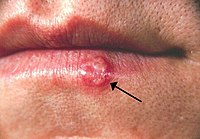
Photo from wikipedia
Atopic dermatitis (AD) is a common inflammatory skin disease, whose incidence is currently increasing worldwide. AD has a complex etiology, involving genetic, environmental, immunological, and epidermal factors, and its pathogenic… Click to show full abstract
Atopic dermatitis (AD) is a common inflammatory skin disease, whose incidence is currently increasing worldwide. AD has a complex etiology, involving genetic, environmental, immunological, and epidermal factors, and its pathogenic mechanisms have not yet been fully elucidated. Identification of AD risk factors and systematic understanding of their interactions are required for exploring effective prevention and treatment strategies for AD. We recently developed a mathematical model for AD pathogenesis to clarify mechanisms underlying AD onset and progression. This model describes a dynamic interplay between skin barrier, immune regulation, and environmental stress, and reproduced four types of dynamic behaviour typically observed in AD patients in response to environmental triggers. Here, we analyse bifurcations of the model to identify mathematical conditions for the system to demonstrate transitions between different types of dynamic behaviour that reflect respective severity of AD symptoms. By mathematically modelling effects of topical application of antibiotics, emollients, corticosteroids, and their combinations with different application schedules and doses, bifurcation analysis allows us to mathematically evaluate effects of the treatments on improving AD symptoms in terms of the patients' dynamic behaviour. The mathematical method developed in this study can be used to explore and improve patient-specific personalised treatment strategies to control AD symptoms.
Journal Title: Journal of theoretical biology
Year Published: 2018
Link to full text (if available)
Share on Social Media: Sign Up to like & get
recommendations!